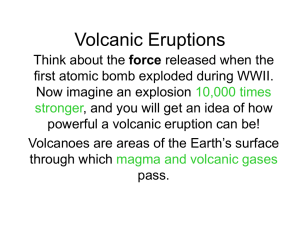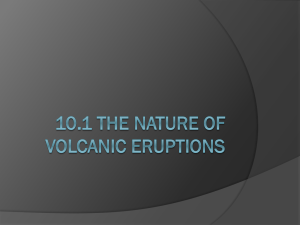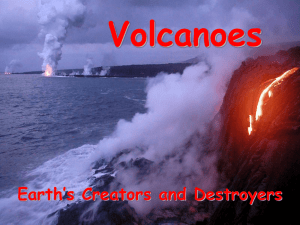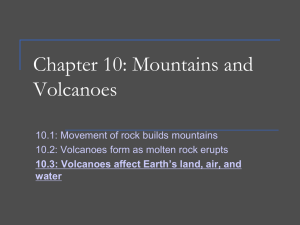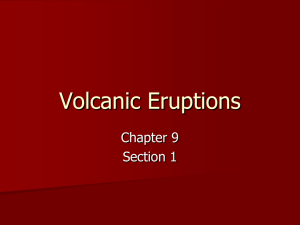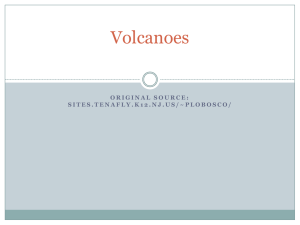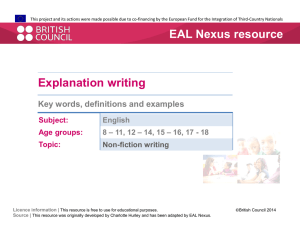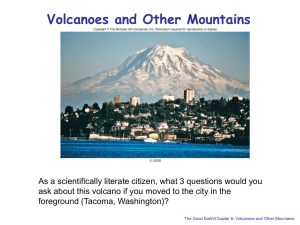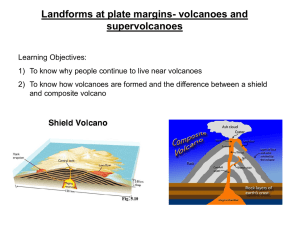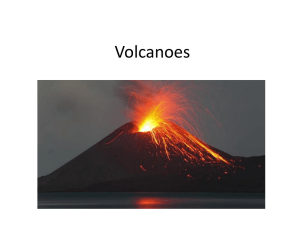Chapter 10: Vulcanicity
advertisement
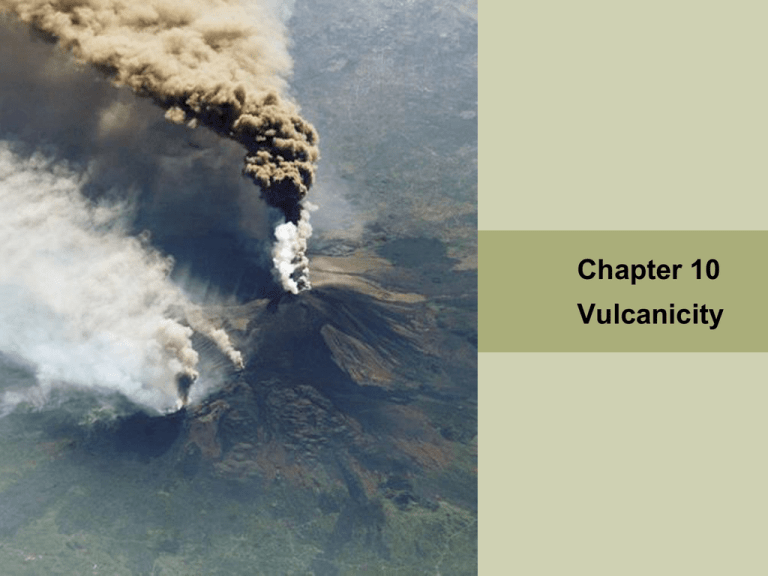
Chapter 10 Vulcanicity Chapter 10: Vulcanicity Vulcanicity • Process whereby magma flows into the earth’s crust or onto the surface • When magma reaches the surface, it is called lava • The type of landform that arises depends on: 1. Location where the magma cools or solidifies 2. Nature of the magma (viscosity, temperature) 3. Means by which the magma reaches the surface Lava – molten rocks Chapter 10: Vulcanicity Location where the magma cools • When magma enters lines of weakness such as faults in the earth’s crust, it may cool underground to form intrusive landforms • When the magma (lava) cools and solidifies on the surface, it forms extrusive landforms Chapter 10: Vulcanicity Intrusive landforms 1. Batholith • Large body of igneous rock that was formed when magma cooled deep within the Earth’s crust 2. Sill Sheet of igneous rock that was formed when magma cooled between older layers of rock Roughly parallel to the surface Does not cut across pre-existing rock layers A batholith in Sierra Nevada Chapter 10: Vulcanicity 3. Dyke • • Mass of intrusive igneous rock that cuts across preexisting rock layers Thickness varies from a few centimetres to many metres 4. Laccolith • • • Igneous intrusion that was formed between two layers of sedimentary rocks and forced the overlying strata to arch up Usually dome- or mushroomshaped Formed at shallow depths by viscous magma A dyke Chapter 10: Vulcanicity Viscosity of the magma • Viscosity refers to the magma’s resistance to flow • It depends on the silica content and the temperature of the magma • Basic magma has low silica content, higher temperatures and lower viscosity (i.e. more fluid) When the magma reaches the surface, it moves quickly and covers large areas before solidifying • Acid magma has high silica content, lower temperatures and higher viscosity (i.e. less fluid) The lava moves slowly and solidifies quickly Chapter 10: Vulcanicity Means by which the magma reaches the surface • Acid magma is associated with explosive eruptions • As the magma rises from deep within the earth, the dissolved gases in the magma expand due to the lower pressure • Because of its viscosity, acid magma does not allow these gases to escape • The gases build up and eventually lead to explosive eruptions • Such eruptions generate a lot of ash and cinders Mt St Helens during an eruption Chapter 10: Vulcanicity Extrusive landforms 1. Lava plateau • • • • Elevated flat-topped platform with steep slopes Height ranges from hundreds to thousands of metres Formed when basic lava escapes through long narrow openings (fissures) in the earth’s crust and spreads out very quickly Over time, the lava accumulates in layers with successive eruptions Chapter 10: Vulcanicity 2. Volcano • • • • • • Formed when lava escapes through a vent The lava and ash accumulate around the vent and cool to form a dome-shaped feature The volcano grows in size through successive eruptions The top of the volcano through which lava is ejected is called the crater A violent eruption may blow the crater off to create a large depression known as a caldera When water collects in the caldera, a crater lake is formed A crater lake Chapter 10: Vulcanicity Structure of a volcano Chapter 10: Vulcanicity Classification of volcanoes 1. Active volcano • • Is showing signs of life by giving off one or more of the following – gases, steam, ash, rocks or lava E.g. Soufrière Hills volcano in Montserrat 2. Dormant volcano • • Currently inactive but may erupt in the future E.g. Mount Fuji in Japan 3. Extinct volcano • • Not expected to erupt again E.g. Mount Kenya in Africa Chapter 10: Vulcanicity Types of volcanoes • The shape and size of the volcano formed depend on the nature of the lava and the way the lava erupted • Types of volcanoes: – Acid lava cone – Basic lava cone – Ash and cinder cone – Composite volcano Chapter 10: Vulcanicity Acid lava cone • Volcano formed from acid lava • Acid lava is viscous and solidifies quickly • The lava is unable to move far away from the crater before it solidifies • The volcano formed has steep sides and a narrow base Grand Etang in Grenada is one of the many explosive volcanoes in the Caribbean Chapter 10: Vulcanicity Acid Lava Cone Chapter 10: Vulcanicity • A volcanic plug may be formed when viscous magma solidifies within the pipe of the volcano and is exposed after years of denudation Shape of original cone Volcanic plug Remnants of the cone Petit Pitons is one of two volcanic plugs Chapter 10: Vulcanicity Basic lava cone • Also called a shield volcano • Basic lava is fluid and has high temperatures of between 1,100C and 1,200C • The lava spreads far from the crater before solidifying • The resultant volcano has a broad base and gentle slopes and is often of low height Mauna Loa in Hawaii Chapter 10: Vulcanicity Basic Lava Cone Chapter 10: Vulcanicity Case study: Hawaiian Islands • The Hawaiian Islands in the Pacific Ocean are the tops of massive undersea shield volcanoes • They were formed far away from the plate boundary as the Pacific Plate has been moving slowly over a hot spot • Hot spots are fixed locations deep within the mantle from which columns of magma rise to the surface • The magma rises to the surface by melting through the crust • As the plate moves, the volcano over the hot spot is slowly carried away and eventually becomes extinct while a new one is formed in its place Chapter 10: Vulcanicity Formation of volcanoes in the Hawaii islands Chapter 10: Vulcanicity • The hot spot is believed to be currently under the island of Hawaii, also known as the Big Island • The entire Big Island is a shield volcano with three active peaks – Mauna Kea, Mauna Loa and Kilauea Chapter 10: Vulcanicity Ash and cinder cone • Acid lava tends to trap large amounts of gases, resulting in violent eruptions • Volcanic rock fragments, called pyroclasts, are ejected with great force • Ash refers to pyroclasts smaller than 4mm while the larger ones are called cinders • Larger pyroclasts fall nearer the summit and form steep slopes • Finer pyroclasts get blown farther and form gentle slopes Mount Bromo in Indonesia Chapter 10: Vulcanicity Composite volcano • Made up of alternate layers of viscous lava, and ash and cinders • The gases trapped in the acid magma eventually lead to a violent eruption • This ejects ash and cinders which settle around the crater • The eruption clears the vent, allowing lava to flow out freely • The lava cools and solidifies over the ash and cinders deposited earlier • Repeated eruptions of ash and cinders followed by lava flows build the composite volcano Chapter 10: Vulcanicity • The violent eruptions may cause cracks along the sides of the volcano • Lava may escape through these cracks, resulting in parasitic cones Chapter 10: Vulcanicity • Mount Fuji in Japan and Mount Mayon in the Philippines are composite volcanoes Chapter 10: Vulcanicity Distribution of vulcanicity • Most volcanoes are located near convergent plate boundaries and coincide with earthquake zones Plate boundary Big earthquake Direction of plate movement Active volcano Destructive Plate Constructive Plate Tsunami occurrences Chapter 10: Vulcanicity • There are also volcanoes in the Caribbean. Below are two shuttle radar maps of Grenada and St. Lucia showing the locations of volcanoes on the islands. Chapter 10: Vulcanicity Benefits of vulcanicity 1. Fertile soil • • • Weathering breaks down the volcanic material into rich soil Many farmers live on the slopes of volcanoes such as Mount Soufrière in St Vincent The soil supports a large variety of crops such as dasheen, cassava and tree crops like bananas and coconuts The banana is one of the crops that grows well in the rich volcanic soils of St Vincent Chapter 10: Vulcanicity 2. Tourism • • • • Volcanoes, hot springs and geysers found in areas of volcanic activity are often tourist attractions Volcanoes can produce beautiful scenery Examples are the Grand Etang crater lake in Grenada and the Pitons in St Lucia The latter have been declared a United Nations World Heritage Site because of their exceptional beauty The Pitons are a world heritage site Chapter 10: Vulcanicity • • • • • Hot springs occur when heated groundwater seeps up to the surface to form a pool of hot water Examples are the Sulphur Springs of St Lucia and the Soufriere hot springs in Dominica Geysers occur when heated water and steam underground are periodically forced up into the air through a vent The eruptions can reach great heights One of the best-known geysers in the world is Old Faithful in the Yellowstone National Park, USA Sulphur springs of St Lucia Chapter 10: Vulcanicity 3. Geothermal energy • • When magma heats up underground rocks, nearby groundwater is heated up as well Steam generated from the heated groundwater can be harnessed to produce electricity 4. Precious stones and minerals • • Minerals such as gold, silver and copper and gemstones such as sapphire and opal can be found in igneous rocks Mining can be carried out to extract these Krafla Geothermal Station in northeast Iceland Chapter 10: Vulcanicity Hazards of vulcanicity 1. Lava flows • • Lava flows burn and bury everything in their path They lead to loss of lives and property, especially when the flow is through a densely populated area Lava flow by the side of the road Chapter 10: Vulcanicity 2. Landslides and mudflows • • Violent eruptions may trigger landslides and mudflows that can bury villages and farmlands In 1985, 23,000 people in the town of Armero were killed when the Nevado del Ruiz volcano erupted and triggered a mudflow Effect of the mudflow in Armero Chapter 10: Vulcanicity 3. Pyroclastic flows • • These clouds of superheated ash and gas from volcanic eruptions can be deadly The 1902 Mount Pelée eruption produced a pyroclastic flow that killed 28,000 people in the town of St Pierre Pyroclastic flows from Soufriere damaged many infrastructure like roads; cars were damaged Chapter 10: Vulcanicity 4. Volcanic blasts • • • Occur when a large amount of energy is suddenly released When the blast is directed sideways rather than into the atmosphere, it can trigger huge floods and mudflows This happened with the Mount St Helens eruption in 1980 which killed 34 people 5. Poisonous emissions • • • The large amount of carbon dioxide released during a volcanic eruption can suffocate humans and animals Ash lingering in the air after an eruption can cause lung problems In 1986, a volcanic eruption caused one of the crater lakes in Cameroon to release an invisible cloud of gases that killed almost 1,800 people in a nearby valley Chapter 10: Vulcanicity 6. Tsunamis • • • Explosive eruptions in the sea can cause tsunamis These giant waves can wipe out settlements near the coast Underwater volcano Kick ’em Jenny off the north coast of Grenada is a potential threat Gas bubbles from the volcano’s vent can cause ships to lose their buoyancy and subsequently sink 7. Environmental effects • • • Sulphur dioxide emitted from volcanic eruptions cause acid rain which pollutes the air and water Sulphur particles released from huge eruptions can remain in the atmosphere for a long time and lead to the depletion of ozone Volcanic ash can cause engine failure of airplanes and increase maintenance costs Chapter 10: Vulcanicity Case study: Montserrat eruptions • Montserrat is one of the islands of the Lesser Antilles • It is the result of the North American Plate subducting beneath the Caribbean Plate • The Soufrière Hills volcano erupted violently in 1995, emitting ash and steam • The eruption started a series of larger eruptions that lasted over two years • 19 people were killed • The capital town of Plymouth was destroyed Cork Hill is one of the ghost towns created by the Montserrat eruptions
